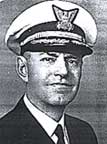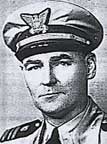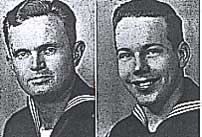
Capt. J. E. Stika, USCG,
Commanding Officer, U.S.Maritime Training Program

Lieut. Cmdr. G.C.
Whittlesey, USCG,
Executive Officer

F.A. Prince, USCG,
Ordnance Officer

(l. to r.) G. Gields, CGM, USCG; H. Plummer,
GM 3/c, USCG; Gunnery Instructors
U.S. Maritime Officers' Training Station, Alameda, California: Gunnery Training
Summer 1942
Under U.S. Coast Guard direction
 Capt. J. E. Stika, USCG, Commanding Officer, U.S.Maritime Training Program |
 Lieut. Cmdr. G.C. Whittlesey, USCG, Executive Officer |
 F.A. Prince, USCG, Ordnance Officer |
 (l. to r.) G. Gields, CGM, USCG; H. Plummer, GM 3/c, USCG; Gunnery Instructors |
Fall 1942
Under U.S. Navy and U.S. Maritime Service direction
 Lt. Comdr. A.G. Ford, USNR, Superintendent |
 Lt. Comdr. H. Norby, USMS, Executive Officer |
 J.L. Sartorius, USN, Ordnance; H.D. Pool, Chief Gunners Mate, USN, Gunnery Instructor |
Who Said We're Not Members of An Armed Force?
Learning to be a good seaman these days calls for more than just learning to be a good deck or engine room hand, pharmacist's mate, ship's clerk, messman, cook or baker. The seafarer has to be specially skilled in saving his own life, in knowing how to use life rafts, preservers, rubber suits and boats -- and he also must know how to pass the ammunition in a more active manner than helping carry it across the world's oceans to the battle fronts.
Here at Sheepshead Bay, every member of Uncle Sam's so-called "unarmed force" gets a minimum of 30 hours of gunnery training.
Under more than 40 instructors in Building G-l, trainees learn the general theory of gunnery and the care, maintenance and operation of guns ordinarily found aboard merchant ships -- in preparation for that moment on the high seas when they may have to take their places to fight off enemy dive bomber, submarine or surface raider.
Each trainee is given fundamental instruction in 30- and 50-calibre machine guns. the .20 millimeter anti-aircraft gun and three- and four-inch deck guns, according to Lt. Walker Laramore, USNR, Station Gunnery Officer.
Assisting Lt. Laramore are Lt. Roy Bieber USMS, Ens. H. N. Casselman. USNR, Ens. J. E. Lambright, USNR, and Gunner J. B. Richardson, USN.
"After his training," Lt. Laramore says, "a graduate of this Station should be qualified to take any position in a crew on the more common types of guns and bear a hand where he is most needed in the event of an attack on his ship or convoy."
Sheepshead Bay Maritime Service Training Station seamen intend to be ready to do more than just "pass the ammunition" to beat the Axis!
Sheepshead Bay Newsletter, HEAVING LINE, April 10, 1943
graphic- Cover of The MAST Magazine April 1944
U.S. Maritime Service Training Station Gunnery Instructor: Jesse Worth Cady
After basic training at USMS Sheepshead Bay Training Station in 1942, Jesse Worth Cady was assigned to Ships Company and and was promoted to Gunner's Mate 3rd Class, then Gunner's Mate 2nd Class, and eventually rose to Chief Petty Officer (Specialist- permanent). As a gunner's mate, Cady trained USMS trainees on 4" 50 and 5" 38 cannons, and 20 mm, 30 and 50 caliber anti-aircraft guns.The Gunnery Building was on the shoreline off the ocean and Cady recalled how they were able to look out and see the ships going out to set up for convoy. He told them that they better know their guns because, "You're going to be there shortly and you better learn what I got to teach, because I'm going to be back here watching you when you go out. It all depends on you."
"Next to our building, there was a gunnery building which had machine guns that operated on air. They sounded real. You'd sit in a room with a big curved screen. Airplanes would dive down at you but instead of shooting bullets, you would fire beams of light. You could register and score your hits to teach you how to shoot and lead an airplane if they were diving at you. You only had a matter of seconds to do it.
"They also had belts where they would put water line ship models and run them across, and you would learn to identify ships by moonlight and starlight, fire and lightening, etc. Every possible thing, so you would know what you were up against. When they didn't have a type of ship, they would give me a picture of the thing and I would make a little model they could put up."
Certificate of Promotion to Gunner's Mate Third Class for Jesse Worth Cady
Designation of Grade from Seaman 1st Class to Gunner's Mate 3rd Class
Signed by Commander G.E. Harrington, U.S. Naval R eserve
Executive Officer, U.S. Maritime Service Training Station, Sheepshead Bay, NYInformation on Jesse Cady provided by his widow, Charmian Cady and daughter, Jane E. Cady. Jane interviewed her father before his death in 1999.
Training at Gunnery Schools in the USARoderick M. (Mike) McHugh
Mike McHugh started sailing in the U.S. Merchant Marine before World War II. He took his gunnery training in 1943 at Sheepshead Bay, NY between voyages. It was given by U.S. Navy officers and men and "included Lewis 30 cal. machine gun, Browning-water cooled 50 cal., Oerlikon 20 mm, and 3 and 5" - 50 cal. Big guns," according to Mike. He noted that before his training various arrangements were made for gun crews. "Aboard the tanker SS Topila, a Navy chief and a first class gunner's mate maintained the guns, and mariners made up the gun crew."McHugh recalled that, "In June of 1943, on the SS James Moore, we were given credit for downing a plane in Oran, North Africa. Earlier on this same ship, we were running the gauntlet between supplying our troops through the Ports of Bone, Oran and Casablanca and being squeezed by Axis forces using low level bombers and subs to stop us. Merchant Seaman, including myself, were standing our regular watches plus a gun watch. These attacks did not always coincide with our watches, leaving us without much rest. Gunnery officers sometimes came aboard our ships with a all "green" gun crew, and frequently asked those of us aboard who had experience to volunteer to help man the guns. We rose to the occasion the best way we could with what we had."
U.S. Maritime Service Gunnery Instruction Certificate issued to Roderick M. McHugh
United States Maritime Service Gunnery Instruction Certificate issued to Roderick M. (Mike) McHugh on March 18, 1943. Signed by G.B. Ritz, USN Gunnery Officer, and Malcolm C. Crossman, Superintendent. Crossman was Superintendent at Sheepshead Bay U.S. Maritime Service Training Station and later became Superintendent of the U.S. Maritime Service Officers School, Alameda, California. McHugh actually took the training at the Sheepshead Bay Training Station although the certificate stated it was at Hoffman Island, NY. (Certificate damaged)
Mike McHugh is a former CEO and a member of the SilverGate Chapter of the American Merchant Marine Veterans, San Diego, California.
Gunnery Card issued to Al Hadad
According to Al Hadad. "My gunnery training made me an expert on the 4" 50 cal gun (WW I vintage), the Lewis machine gun (also WW I) and the Colt .45 automatic pistol. The cannon had a 30 cal. rifle mounted on top of the barrel and we would fire it at a target half a mile away in New York harbor."
Hoffman Island, New York Gunnery School. 1, April, 1942.
Hadad, A.S. Qualified to Serve as a Member of Gun Crew for Armed Guard Duty.
E.T. Piner, Lieut J.G., U. S. Coast Guard
3/19/02
www.USMM.org ©1998 - 2002. You may quote small portions of material on this website as long as you cite American Merchant Marine at War, www.usmm.org as the source. You may not use more than a few paragraphs without permission. If you see substantial portions of any page from this website on the Internet or in published material please notify usmm.org @ comcast.net